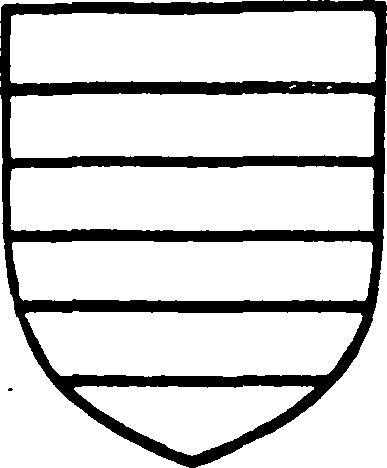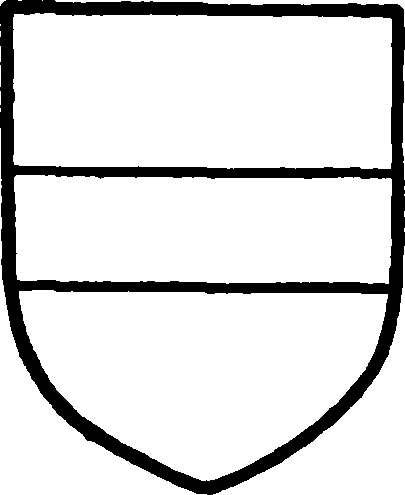Pages 155-157
A History of the County of Rutland: Volume 2. Originally published by Victoria County History, London, 1935.
This free content was digitised by double rekeying. All rights reserved.
In this section
THISTLETON
Tistertune, Tisteltune (xi cent.); Tystelton, Thysteltun, Thistilton (xiii cent.); Tylystineton (xiv cent.); Thissleton (xvii cent.).
The parish of Thistleton, which stands to the north of the county, is bounded on the north partly by the Leicester and partly by the Lincoln county boundaries, and on the east by the Lincoln county boundary. It comprises 1,379 acres of land, which has a general slope from west to east. The subsoil is Inferior Oolite; more than half of the land is arable and the remainder grass land. The decreasing population, which was only 105 in 1921, (fn. 1) is indicated by the number of cottages in the village falling into decay. The church stands in the centre of the small village, which is built along the by-road from Market Overton to the Great North Road that skirts the eastern boundary of the parish. The farm houses and cottages are chiefly of stone with stone or thatched roofs. The nearest railway stations are at South Wytham, 1¼ miles north-east, on the London Midland and Scottish and London and North Eastern Railways, and at Ashwell, 5 miles south-west, on the London Midland and Scottish Railway.
There was in 1576 a dispute about the boundaries between the manors of South Wytham and Thistleton; and the Thistleton localities of Woodleyes, Redhill Furlong and Stonegravehill are mentioned. (fn. 2) There was an Inclosure Act for the parish in 1759. (fn. 3)

Bussey. Barry argent and sable.
Manors
At the time of the Domesday Survey there appear to have been two holdings in THISTLETON. One was held of the Conqueror's niece, the Countess Judith, and later of the Honour of Huntingdon, and the other was apparently held of the Crown. The former comprising half a carucate was held in the time of Edward the Confessor by Erich. In 1086 Hugh held one plough and 6 villeins with one plough of the Countess, (fn. 4) and it has been thought that this Hugh was ancestor of the family of Bussey (Busey, Bushey, Bucy) who later held the manor. The Busseys were a Lincolnshire family; Hugh de Bussey presented to the church of Merston (co. Linc.) in 1173, and was apparently living in 1203. (fn. 5) His son Lambert was living in the reign of King John, (fn. 6) and presented to the church of Thistleton in 1226. (fn. 7) Hugh de Bussey who in 1242–3 was holding the manor of Hougham (co. Linc.) which Lambert had held in 1212 (fn. 8) may have been his son. Hugh presented to the church of Thistleton in 1249, and he possibly was the Hugh de Bussey who presented in 1261. (fn. 9) Lambert de Bussey was dealing with the manor of Horn (q.v.) in the latter part of the reign of Henry III, (fn. 10) and Hugh, son of Lambert de Bussey, settled two parts of the manor of Thistleton in 1290. The other third part, which was held as dower by Elizabeth, then wife of John Daubeny, mother of Hugh by her former husband Lambert de Bussey, (fn. 11) which ought to have reverted to Hugh on the death of Elizabeth, was to remain to Robert Cofyn. (fn. 12) Hugh presented to the church in 1276, was assessed for half a fee in Thistleton in 1305, and died in 1306. (fn. 13) His son (fn. 14) Sir John was lord in 1306–16, (fn. 15) and was succeeded by a son John, and he by a son Walter. The celebrated Sir John 'Bushey,' sheriff of Lincoln, Speaker of the House of Commons, mentioned in Shakespeare's Richard II, was son and heir of Walter. He was executed by Henry IV in 1399. (fn. 16) His son, John de Bussey, (fn. 17) was tenant of this half fee in 1428. (fn. 18) John, son of the last-named John, was father of Hugh, father of Sir Miles, (fn. 19) whose son John was in litigation about lands in Rutland in 1515–18. (fn. 20) He made a settlement of the manor and advowson in 1536, (fn. 21) and died within the year. (fn. 22) His daughter and heir Agnes and her husband, Edmund Brudenell, afterwards knighted, received livery of the manor in 1542. (fn. 23) Thus the manor passed from the Busseys after it had been some 400 years in the male line of the Bussey family. Jane Bussey, aunt of Agnes, had married Thomas Meres (Meares), and her son Francis left a son Anthony Meres, who was heir to Agnes Brudenell at her death in Jan. 1583. (fn. 24) Anthony at once conveyed the manor and advowson to Sir Edmund Brudenell (fn. 25) of Deane (co. Northant.). Just before his death in 1585 Sir Edmund settled this manor and advowson on his brothers Thomas, John, Robert, William, his cousins Edmund, George (and his son Paul), Thomas and William, sons of his uncle Anthony Brudenell, successively, in tail male, bequeathing an annuity to his only child, a daughter, Etheldreda. (fn. 26) John, Edmund and Christopher Bussey and Thomas Austyn quitclaimed the estate in 1589–90 to John, William and Robert Brudenell, three of the above brothers, and Thomas, William and John, sons of Robert; (fn. 27) and Thomas son of Robert, as Sir Thomas Brudenell bart., (fn. 28) made a settlement in 1614. (fn. 29) From this date the manor followed the descent of Ayston until the death of George Brydges Brudenell in 1801. It then passed to his sister Caroline, who married Sir Samuel Fludyer, first baronet. He was succeeded by his son Sir Samuel (d. 1818), and he by his son Sir Samuel, who died unmarried in 1876. The manor then passed to his cousin, the Rev. Sir John Henry Fludyer (d. 1896), whose son, Sir Arthur John Fludyer (d. 1922),sold the property about 1920 to Lt.-Col. John Maurice Wingfield of Tickencote, D.S.O., O.B.E. Col. Wingfield died in 1931, and was succeeded by his nephew, Mr. John Llewellyn Parry, who took the name of Wingfield and is the present owner. (fn. 30)
In 1286 Hugh de Bussey claimed view of frankpledge time out of mind, (fn. 31) though the lords of Oakham (q.v.) had the view here.

Colville of Bytham. Or a fesse gules.
The SOUTH WYTHAM LANDS in Thistleton appear in the 13th century in the possession of the Colvilles of Castle Bytham (co. Linc.) and Weston Coleville (co. Camb.). (fn. 32) In 1252 Simon de Capella and Maud his wife conveyed to Hugh de Bussey (lord of the manor of Thistleton) a messuage, 14 bovates of land, and 20s. 8d. rent here, with the services of Nicholas de Weston and William de Wyme (Wytham) and their heirs. (fn. 33) Sir Walter de Colville's lands in Barrow and Thistleton were seized in 1265, (fn. 34) but they were restored, and he died holding 2 virgates here of Sir Richard de Seyton by the service of 1 lb. pepper yearly. (fn. 35)
In the returns of 1316 Master Robert Bernard appears as the overlord. (fn. 36) From the Colvilles this land descended to Ralf Basset, kt., (fn. 37) whose will was dated at Castle Bytham in 1377. (fn. 38) Of the two daughters he mentions, Elizabeth, who died in 1451, married Richard, Lord de Grey, and had a daughter Elizabeth married to John la Zouche. Elizabeth de Grey gave these lands in 1443–4 to John and Elizabeth la Zouche, although she left a grandson Henry Grey. (fn. 39) No further reference to these lands has been found.
The Berkeleys and Husseys had lands in Thistleton in 1524; (fn. 40) and in 1639 John Lambert died seised of tenements 'in South Wytham in Thisleton,' held in chief of the king. (fn. 41)
Church
The church of ST. NICHOLAS (fn. 42) consists of an apsidal chancel 21 ft. by 15 ft., with north organ-chamber and vestry, nave 41 ft. by 18 ft., south porch, and west tower 8 ft. square, all these measurements being internal. With the exception of the tower, which is of 14th-century date, the whole of the church was rebuilt in 1879–80 at the charges of the Rev. Sir J. Henry Fludyer, bt., rector. (fn. 43) The chancel and the south side of the nave are faced with ashlar, the tower and the north wall of the nave being of rubble; the roofs are covered with Collyweston slates. The building is in the style of the 14th century, and the chancel is of a somewhat elaborate design. On plan it terminates externally as a half-octagon, with a circular window in the east wall, and a single-light cinquefoiled window in each of the canted sides. Internally, the end of the chancel is semicircular, and is lined with ashlar; in the reredos is a terracotta panel of the entombment of Christ, and on the wall of the apse, supported on brackets, terra-cotta statues of the four Evangelists. The chancel arch is of two chamfered orders, the inner order on moulded corbels. The nave is lighted on the south side by three pointed windows of two trefoiled lights and on the north by a single-light window near the east end; the walls are plastered. The open-timbered porch has a stone base and angle piers, with outer oak doors.
The tower is of three stages with large clasping buttresses, battlemented parapets, angle pinnacles, and gargoyles. In the bottom stage is a pointed west window of two cinquefoiled lights, below which a modern doorway has been cut through the moulded plinth. The two lower stages are blank on the north and south sides, but on the west there is a pierced quatrefoil opening. The pointed bell-chamber windows are of two trefoiled lights with quatrefoil in the head. There is a vice in the south-west angle. The arch to the nave is of two orders, the inner with a broad chamfer on half-round responds with moulded capitals and bases, and the outer order with a continuous hollow chamfer.
The font and pulpit are modern. There is a brass tablet to William Towell ' for 56 years parish clerk and 34 years schoolmaster in this village,' who died in 1915, aged 92 years.
There is one bell in the tower cast by George Hedderley, of Nottingham, in 1793. (fn. 44) A clock was erected in 1887. (fn. 45)
The plate consists of a cup of 1757, and a paten probably of the same date. (fn. 46) There is also a pewter plate.
The registers before 1812 are as follows: (i) all entries 1574–1698; (ii) baptisms and burials 1717–87, marriages 1717–54; (iii) baptisms and burials 1788–1812; (iv) marriages 1754–92; (v) marriages 1792–1812. There is a gap 1698–1717.
Advowson
The first mention of the advowson is in 1226, when Lambert de Bussey presented John de Bussey; (fn. 47) again in 1250 it was in the possession of the lord of the manor (q.v.), with which it descended until 1920, (fn. 48) when Sir Arthur John Fludyer sold the manor but retained the advowson. On the death of Sir Arthur in 1922 the advowson passed to his nephew, Mr. Vere Finch, who in 1926 gave it to the Bishop of Peterborough, when the benefice was united to Market Overton. The living is a rectory in the alternate gift of Mr. John L. Parry-Wingfield and the Bishop of Peterborough.
Henry Forster, gent., of Thistleton, who died aged 91 in 1702, bequeathed lands in Lincolnshire to the 'vicarages' of Whissendine, Stretton and Greetham, and £10 a year to every schoolmaster of Thistleton and other places to teach poor children 'to read in the English bible, and to learn them the catechism used in the Church of England.' He further settled an estate of £6 per annum in Thistleton for the above purposes. (fn. 49)
There are no charities in this parish.


